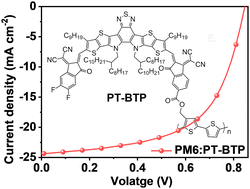A double-cable Y-series-based polymer acceptor for efficient all-polymer solar cells: a new strategy of polymerizing small molecule acceptors†
Abstract
Further advancement of all-polymer solar cells (all-PSCs) requires a new polymerization design strategy to develop ideal polymer acceptors that possess and retain maximally the advantages of narrow bandgap non-fullerene acceptor building blocks. In this work, we report a new design strategy to synthesize a polymerized small molecule acceptor PT-BTP with a double-cable structure composed of a fused-ring Y-series acceptor framework as a pendant side unit and thiophene derivative as the conjugated backbone. PT-BTP exhibits a narrow optical bandgap of 1.35 eV and high electron mobility as well as a favorable BHJ blend morphology when blended with polymer donor PM6, resulting in good photovoltaic performance. The optimized PM6:PT-BTP all-PSCs displayed a high PCE of 12.13% with an energy loss (Eloss) of 0.566 eV and a small non-radiative recombination loss (ΔE3) of 0.227 eV. In contrast, the as-cast devices only showed a lower PCE of 8.14% with inferior Eloss and ΔE3 values. This work enables a new molecular design direction to construct narrow bandgap PAs toward successful applications in high-performance all-PSCs.

- This article is part of the themed collection: Journal of Materials Chemistry C HOT Papers


 Please wait while we load your content...
Please wait while we load your content...